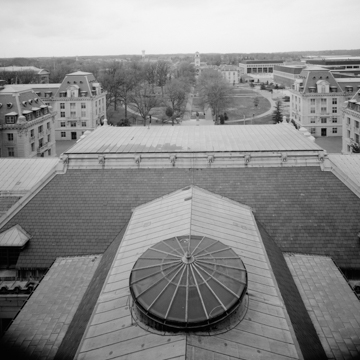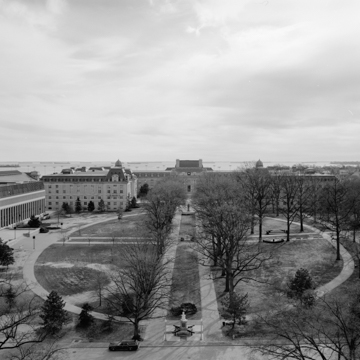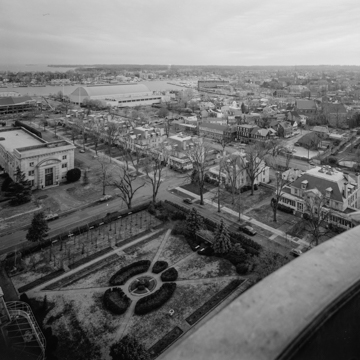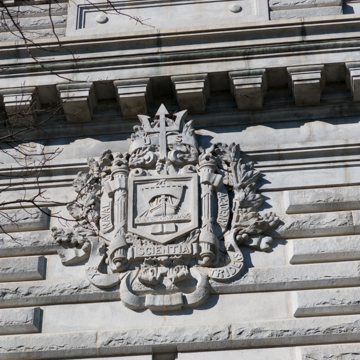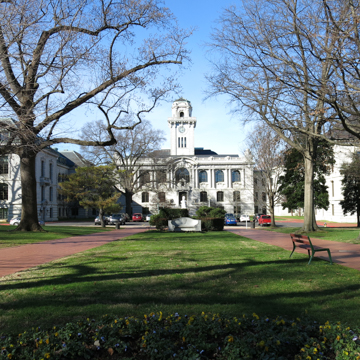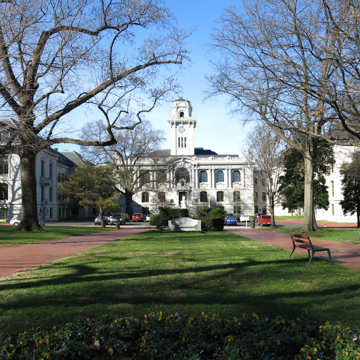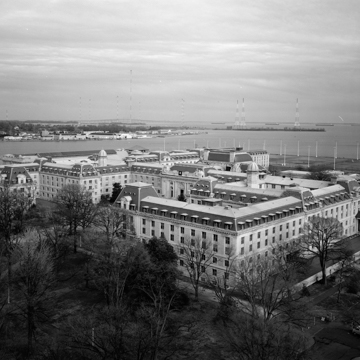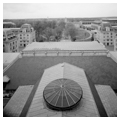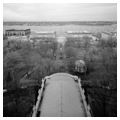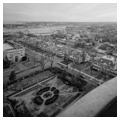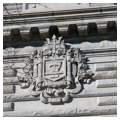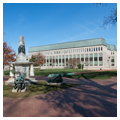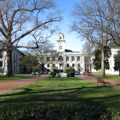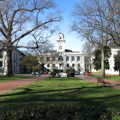In 1896 Beaux-Arts-trained New York City architect Ernest Flagg was commissioned to create a new comprehensive plan for the U.S. Naval Academy. The school for U.S. naval officers was founded in 1845 at Fort Severn and grew in a piecemeal fashion to include over 50 buildings. Flagg’s design ultimately replaced all the nineteenth-century construction except for two small buildings at the main gate, the waiting room (1878) and the guard house (1881). Between 1899 and 1910, 27 buildings were constructed, including a core group of monumental French-influenced classical buildings designed by Flagg and arranged around a formal quadrangle. Despite shortfalls in the construction budget, the academy represents a remarkably fully realized example of a Beaux-Arts scheme and one of the first forays by the U.S. government into design based on those principles. It predates the transformation of the monumental core of Washington proposed by the Senate Park Commission Plan (popularly known as the McMillan Plan) in 1901, as well as redevelopment of the U.S. military academy at West Point (1902–1903, Cram, Goodhue and Ferguson).
The experience of the 1898 Spanish American War and growing awareness of the importance of naval supremacy for America’s international affairs hastened the planned rebuilding. Flagg transformed the Naval Academy campus into a cohesive monumental ensemble, retained the existing mature trees, and overlaid the curvilinear paths with an axial grid. The centerpiece was the quadrangle, also called the Yard, which was designed to be open on one side with views to the Severn River.
Flagg arranged his key buildings around the other three sides of the Yard. At center facing the river, the monumental domed chapel is located at the highest point on the campus and grouped with an administration building and the superintendent’s residence. The massive dormitory and mess hall for the midshipmen, Bancroft Hall, sits on the southeast side of the Yard. Colonnades connect Bancroft Hall to its flanking structures—Macdonough Hall (built as a boathouse and quickly converted into a gymnasium) and Dahlgren Hall (originally an armory). The remaining side of the Yard features the academic group of three attached buildings. Mahan Hall, designed as the library and auditorium with an impressive central tower, is flanked by two classroom buildings—Maury and Sampson halls—connected to its front corners. Flagg also designed a row of officers’ houses placed along the perimeter wall at King George Street as a transition to the adjacent neighborhood.
Flagg’s ornate buildings were initially to be executed in red brick and limestone, in deference to characteristic historic architecture of Annapolis. A politically motivated order from Congress to use New England granite as the primary building material altered the preliminary plans. Soon after construction began in 1899, both construction costs and enrollment increased dramatically, making the planned appropriations inadequate. While granite was used for several buildings in the early phases of construction, soon Flagg was pressed to revise his designs for lower costs. Terra-cotta and gray-faced brick were substituted for granite to maintain design cohesiveness. While Flagg lamented these constraints, the need for economy did inspire him to develop innovative solutions. His use of structural concrete, particularly for the framing and dome of the chapel, was widely celebrated as the most advanced use of that technology in the United States at that time.
While Flagg’s buildings and master plan still define the character of the Naval Academy, there have been several later building campaigns to accommodate the growth of the institution. Between 1918 and 1924, 7 buildings were added, with another 25 structures added in 1939 to 1941. A major project to fill in Dewey Basin at the Severn River side of the Yard was initiated in 1957, adding over 50 acres to the campus. A new master plan prepared by John Carl Warnecke and Associates in 1964 was informed by Flagg’s original one but called for major new construction on the fill. Michelson and Chauvenet halls were placed on a low terrace with an opening to preserve a river view from the chapel. However, Flagg’s power plant and some other buildings were demolished in the process. Today the 300-plus-acre grounds include more than 200 major buildings for use by over 4,500 midshipmen.
References
Bacon, Mardges. Ernest Flagg: Beaux-Arts Architect and Urban Reformer. Cambridge: MIT Press, 1986.
Flagg, Ernest. “New Buildings for The United States Naval Academy, Annapolis, Md., Part I and Part II.” The American Architect and Building News 94, no. 1697-1698 (July 1, 1908 and July 8, 1908): 1-7, 9-13, Plates.
“U.S. Naval Academy.” In Architecture in Annapolis: A Field Guide, edited by Marcia M. Miller and Orlando Ridout V, 203-208. Crownsville, MD and Newark, DE: Vernacular Architecture Forum and Maryland Historical Trust Press, 1998.


